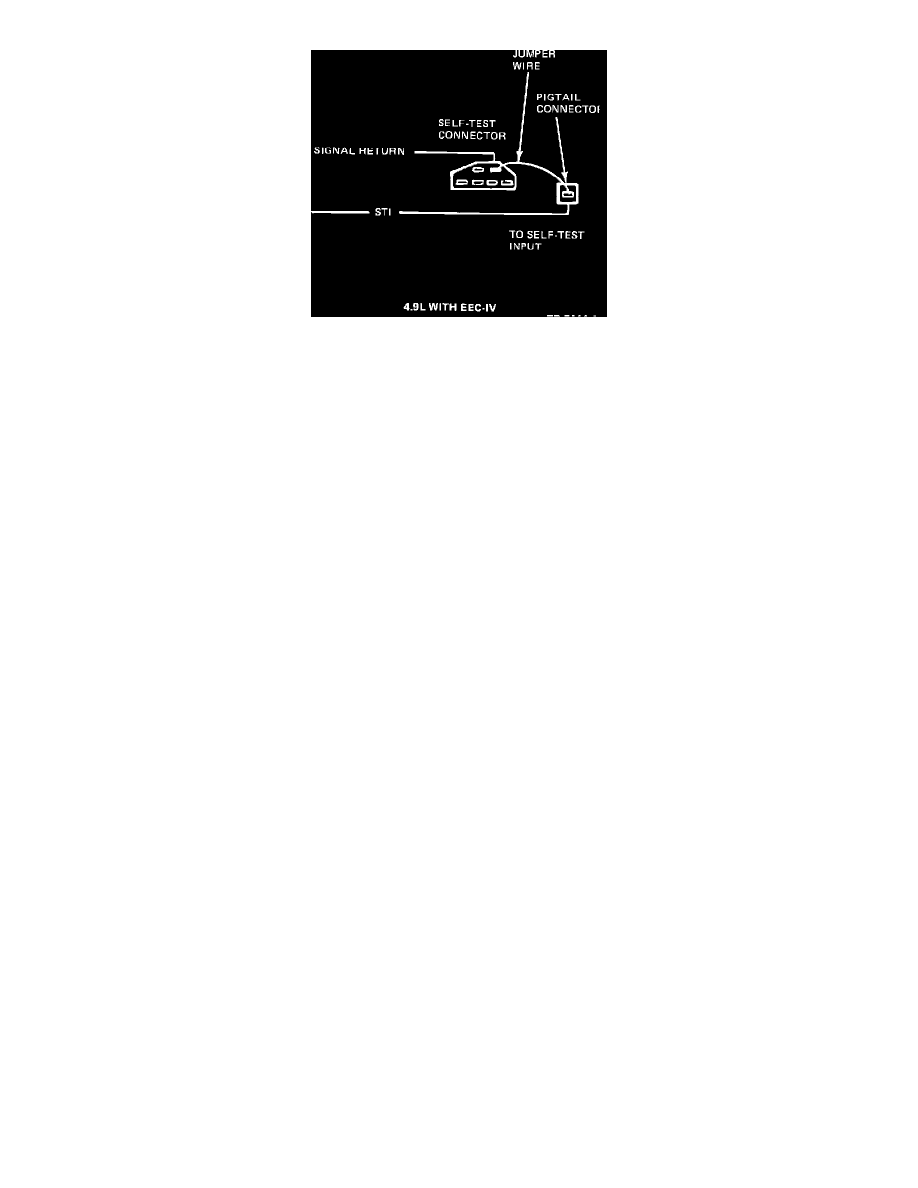E 250 Van L6-300 4.9L (1984)

FIGURE 13
3.
Shut engine off and remove air cleaner (plug open vacuum hose). In the engine compartment, locate the self-test connector and self-test input
(STI) connector. These two connectors are located next to each other (Figure 13).
4.
Connect a jumper wire between the STI connector and the signal return pin on the self-test connector.
5.
Turn the ignition key to the run position. DO NOT START ENGINE.
6.
The ISC plunger will retract. Wait about ten (10) seconds.
7.
Shut off the key.
8.
Remove the jumper wire.
9.
At this point, the idle speed motor should be retracted allowing the throttle to rest against the anti-diesel screw. Unplug the ISC electrical
connection. If the idle speed motor is not retracted, refer to the 4.9L Quick Test, Section 22 of the 1984 Car/Truck Shop Manual, Volume H.
10.
Start engine and verify that anti-diesel setting is below 550 RPM in neutral.
11.
If it is higher than 550 RPM, remove tamperproof cap and reset to 500 RPM.
12.
Install a new tamperproof cap (Part No. E3PZ- 9C984-A) and reconnect the idle speed motor electrical connection. Whenever the idle speed motor
is replaced, it will be necessary to readjust the Maximum Extension setting for the idle speed motor as outlined in the 1984 Car/Truck Shop
Manual (Volume H Section 4-81)
If the curb idle speed is still out of specification, then the following EEC diagnostic procedures should be followed:
1.
Run the Quick Test with the STAR Tester and record the codes. Refer to the 1984 Car/Truck Shop Manual (Volume H Section 22).
2.
Follow the correct Pinpoint Test as indicated by the results of the Quick Test. Pinpoint tests are located in the 1984 Car/Truck Shop Manual
(Volume H Section 25).
If a rough idle condition exists, and the curb idle is as specified, perform the following diagnostic procedure in sequence until the concern is resolved:
1.
Run QUICK test with the STAR Tester and verify a PASS Code 11.
2.
Propane the engine as outlined in the 1984 Car/Truck Shop Manual (Volume H Section 4-133).
3.
If the propane gain is within specification (10-90 RPM) then set the mixture screw to the low side of the specification to improve the idle quality.
4.
If the rough idle condition still exists, run Step 7.0 (Diagnostics by Symptom) of the Quick Test.
NOTE:
DO NOT BY ANY MEANS ARTIFICIALLY INCREASE THE IDLE RPM ON THE ANTI-DIESEL SCREW. This will override the idle
speed motor and cause erroneous calculations within the EEC system. This, in turn, could cause other concerns to arise, including intermittent
operation in the failure mode.
Other items relevent to the 4.9L truck engine diagnostics include:
A.
Electrical connectors which are not pushed all the way in create intermittent concerns. Check the electrical connections at the idle speed motor and
the EEC IV power relay (located near the processor under the dash).
B.
Sometimes the pins in the electrical connector attaching the power relay are not locked in all of the way. They may get pushed out of the connector
when the relay is installed.
C.
On 1984 4.9L trucks equipped with the EEC IV system and automatic transmission, the following items may be observed:
1.
When the engine is throttled in neutral, the speed may remain at about 1000 to 1300 RPM for about 10 to 20 seconds, and then return to 750 RPM.
2.
As long as the engine drops to 600 RPM in drive, then the system is operating correctly and the momentary speed condition described in Step 1 is
considered normal.
D.
Low engine coolant level can result in out of specification curb idles due to unusual or abnormal ECT (engine coolant temperature) sensor
readings. It is important that the correct coolant level be maintained on all 1984 4.9L trucks.
E.
The Cruise Control chain should not be adjusted so tight that it impedes idle speed motor control of the throttle at idle.
